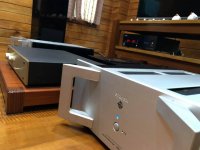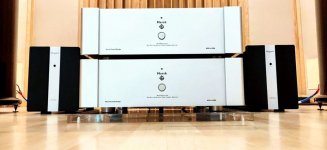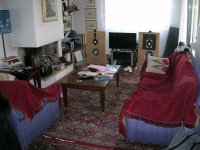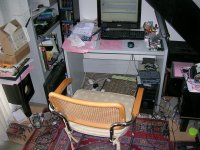ALAAARM ! Business at 11 hour, ALAAARM ! Everyone on the deck. Free fire!That's your amp at the high end audio show 7-8-9 2020?
Richard, why is your logo inverted on the amp and the flyer ?
Last edited:
So that’s your way of listening.Hmmm. More assumptions.... "you" listen further away. YOU meaning others? I never listen critically to sounds far away. I have said this before, I listen up close and personal. Headphone also. That is to avoid the distortions from the room/acoustics.
However, when I want to relax and sit further away on a sofa, I use speakers which have minimum dispersion to the sides. QUADs have a null on the sides. The JBL M2 is directional over a more narrow horizonal path and has constant power response.
Wide, uncontrolled dispersion drivers are a disaster for far field listening. If you wish to only listen in far field, use more narrow dispersion speaker systems. Keep reflections to a minimum before hitting your ears. Use selective location of side wall and floor absorption at least.
THx-RNMarsh
When I listen I sit in a equilateral triangle to both speakers, which in my case
is ca. 3.5 meters, speakers looking exactly in my direction.
A shorter distance, without moving the speakers, does not give one wide integrated sound stage.
Curious to know how other contributors of this thread are positioned while listening.
Hans
Hmmm. More assumptions.... "you" listen further away. YOU meaning others? I never listen critically to sounds far away. I have said this before, I listen up close and personal. Headphone also. That is to avoid the distortions from the room/acoustics.
However, when I want to relax and sit further away on a sofa, I use speakers which have minimum dispersion to the sides. QUADs have a null on the sides. The JBL M2 is directional over a more narrow horizonal path and has constant power response.
Wide, uncontrolled dispersion drivers are a disaster for far field listening. If you wish to only listen in far field, use more narrow dispersion speaker systems. Keep reflections to a minimum before hitting your ears. Use selective location of side wall and floor absorption at least.
THx-RNMarsh
I’ve seen a few refurbished ‘57’s and ‘63’s for sale. I’m wondering if I should give them a go - should be good with classical and jazz which I listen to a lot. My dedicated listening space is quite compact (maybe 15 feet x 20).
Anyone got any tips for what to avoid/look out for? Hans maybe you can also comment?
So that’s your way of listening.
When I listen I sit in a equilateral triangle to both speakers,
Hans
So do I. In near field.
How do you do that with headphones?
-RNM
OMG, he is almost using his speakers as headphones. 😀😀
That’s very near fielded indeed, not very comfortable to listen to music IMO.
Hans
I really liked AKG K1000 when I listened to them. Would probably never use them for various reasons, but they sounded great.
Joachim listens a lot to the music at night with a glass of wine in a relaxed mood (as much as this is feasible considering his super active character)That’s very near fielded indeed, not very comfortable to listen to music IMO.
Attached, my case.
Far listening (sitting on one of the two sofas) at the living room or close listening at the PC desk
George
Attachments
For when you think you are having a bad day...
Angela Hewitt's rare Fazioli piano dropped by movers - CNN
Angela Hewitt's rare Fazioli piano dropped by movers - CNN
I’ve seen a few refurbished ‘57’s and ‘63’s for sale. I’m wondering if I should give them a go - should be good with classical and jazz which I listen to a lot. My dedicated listening space is quite compact (maybe 15 feet x 20).
Anyone got any tips for what to avoid/look out for? Hans maybe you can also comment?
Be careful with refurbished Quad’s.
Refurbished diaphragms may be covered with some cheap DIY carbon film substance instead of the real coating, with negative impact on the quality of the sound reproduction.
My restricted experience with the ESL in 3 different houses with large rooms is that they seem to prefer to stand 1 to 1.5 meters from the rear wall.
And although they don’t radiate at 90 degrees, they seem to prefer to stay at least the same distance from the sidewalls.
But I know people with very small rooms where sound is remarkable good at one single spot as long you keep the equilateral triangle set up with the speakers pointing in your direction, in that case only 1 to 1.5 meters from the Quad’s
Hans
<snip>
The reason you don't give proof is NOT because it is hard, expensive or time consuming. It is because you are chasing dragons. Hard facts will burst your bubbles.
Isn't stating opinion as fact in the "sloppy" category? 😉
But is the martin logan approach of a curved stator a better way of doing it? I had a pair of aerius for demo once and did like them a lot.
As usual it depends; in general analysis start with the (always not true) assumption of a uniform membrane motion (unfortunately it has to be fixed to a frame structure) and a curved stator/membrane structure must have several additional stabilizers to prevent the thin film from touching the stator and the result will be some kind of distortion.
Segmentation, as done in the ESL 63 and newer models, will essentially have a similar problem too, although measurements (listening as well) show evidence for a very good compromise.
But it could be one of the reasons why some people still prefer the older ESL mark1 (often named es ESL 57) as it is a two way electrostat (two bass panels and one high frequency panel in the middle) without any further segmentation or curved structure.
Beveridge afair tried to solve the dispersion problem with a wooden acoustic lens structure.
One other thing about the durability of the ESL63.
The first set I bought, shortly after their introduction, went down every two or three years, costing me a fortune to get them repaired by Quad.
Then I had the opportunity to buy an ESL Pro set from the discontinued Polydor studio from Philips. These are ruggedized versions with steel frames, in my case without the black grille cloth.
These socks btw are hindering the HF in some way.
Without them the sound becomes as, yes as if you remove a thin curtain.
But with these versions I never had any problems for at least 25 years.
It seems that a number of improvements where made during production, like better diodes, a redesigned HV board, better glue to fix the diaphragm to the frame etc.
So when buying an ESL63, be sure they are from after 1990.
I may hope that the Chinese have adopted all these improvements.
Hans
The first set I bought, shortly after their introduction, went down every two or three years, costing me a fortune to get them repaired by Quad.
Then I had the opportunity to buy an ESL Pro set from the discontinued Polydor studio from Philips. These are ruggedized versions with steel frames, in my case without the black grille cloth.
These socks btw are hindering the HF in some way.
Without them the sound becomes as, yes as if you remove a thin curtain.
But with these versions I never had any problems for at least 25 years.
It seems that a number of improvements where made during production, like better diodes, a redesigned HV board, better glue to fix the diaphragm to the frame etc.
So when buying an ESL63, be sure they are from after 1990.
I may hope that the Chinese have adopted all these improvements.
Hans
Last edited:
So do I. In near field.
How do you do that with headphones?
-RNM
I never listen to music with headphones, they give me a claustrophobic feeling.
Hans
kgrlee answered to my PM.
He is still with us 🙂
George
Thank you.
Good to hear.
Hans
I’ve read something about genetics having a lot to do with your tolerance for loud noise/music.
We seem to have a wealth of listening experts here but a dearth of hearing experts.
Peter Walker wrote an article in three parts about the electrostatic transducer in the Wireless World 1955.
Baxandell covered a lot in his chapter of Borwick's Loudspeaker & Headphone Handbook (iirc the triple stacked ESL was proposed by him)
Nearly forgotten; two nice members of diyaudio published two articles about ESLs (and contributed a lot in the diyaudio section):
D. R. WHITE; Wide-Range Electrostatic Loudspeaker with a Zero-Free Polar Response*; J. Audio Eng. Soc., Vol. 57, No. 10, 2009 October, 822)
D. ROD WHITE, STEPHEN T. BOLSER; Acoustic Transparency of Electrostatic Loudspeaker Assemblies; J. Audio Eng. Soc., Vol. 65, No. 6, 2017 June, 497
@Bonsai,
If the ceiling height (and some other considerations 🙂 ) allows for it, look for 4 or 6 "ESL 57", if stacked between floor and ceiling it will be a quite good approximation of a true line souce, triple (for example) amping in combination even with modern equalization per DSP it surely will be an extraordinary reproduction system. If needed an additional stack of ripol subs will add nicely ......
@Hans Polak,
the steel frame (wasn't it by ?Arcisi?) was IMO an impressive progress and the newer chinese models tried to do something similar (therefore the additional strut on the backside for further stabilization.
Baxandell covered a lot in his chapter of Borwick's Loudspeaker & Headphone Handbook (iirc the triple stacked ESL was proposed by him)
Nearly forgotten; two nice members of diyaudio published two articles about ESLs (and contributed a lot in the diyaudio section):
D. R. WHITE; Wide-Range Electrostatic Loudspeaker with a Zero-Free Polar Response*; J. Audio Eng. Soc., Vol. 57, No. 10, 2009 October, 822)
D. ROD WHITE, STEPHEN T. BOLSER; Acoustic Transparency of Electrostatic Loudspeaker Assemblies; J. Audio Eng. Soc., Vol. 65, No. 6, 2017 June, 497
@Bonsai,
I’ve seen a few refurbished ‘57’s and ‘63’s for sale. I’m wondering if I should give them a go - should be good with classical and jazz which I listen to a lot. My dedicated listening space is quite compact (maybe 15 feet x 20).
Anyone got any tips for what to avoid/look out for? Hans maybe you can also comment?
If the ceiling height (and some other considerations 🙂 ) allows for it, look for 4 or 6 "ESL 57", if stacked between floor and ceiling it will be a quite good approximation of a true line souce, triple (for example) amping in combination even with modern equalization per DSP it surely will be an extraordinary reproduction system. If needed an additional stack of ripol subs will add nicely ......
@Hans Polak,
the steel frame (wasn't it by ?Arcisi?) was IMO an impressive progress and the newer chinese models tried to do something similar (therefore the additional strut on the backside for further stabilization.
Last edited:
- Status
- Not open for further replies.
- Home
- Member Areas
- The Lounge
- John Curl's Blowtorch preamplifier part IV



